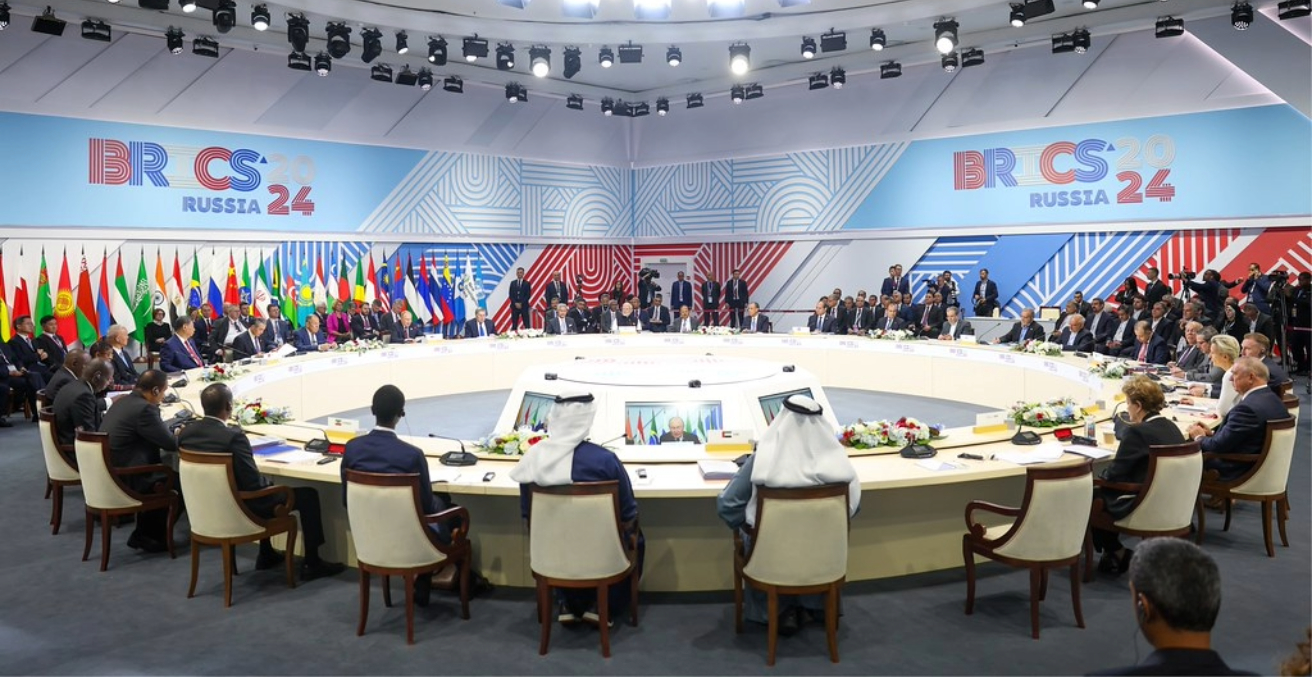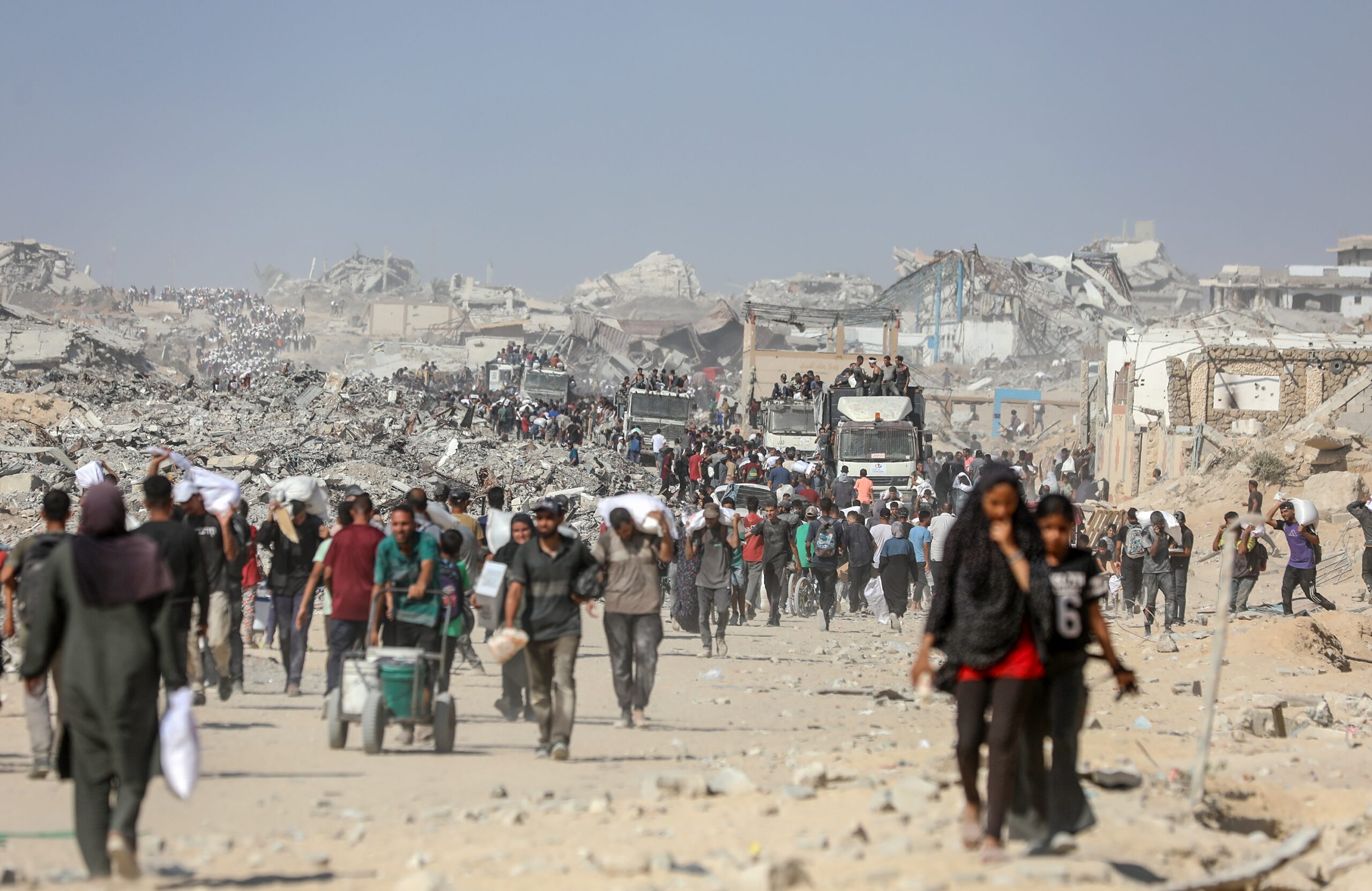BRICS’ expansion and evolving financial initiatives highlight its dual role as both a symbol of Global South solidarity and a platform marked by internal divisions. While it challenges Western-led institutions through parallel structures and alternative governance models, its cohesion remains uncertain amid diverging national interests.
Introduction: deconstructing the BRICS dichotomy
BRICS’ recent expansion to incorporate Iran, Egypt, Ethiopia, and the UAE highlights its growing importance in the international landscape and is a subject of academic and policy debate. This debate often highlights the bloc’s dual nature as a “symbol of the non-Western world’s rise and a group with internal inconsistencies.” As BRICS is pivoting its role in reshaping the global financial landscape, promoting justice, and supporting sustainable development, questions arise: Is BRICS a genuine revisionist bloc intent on overturning the existing global order, or is it a mere forum for anti-Western rhetoric with little substantive impact to reshape the global financial landscape?
The existing international monetary system faces pressures that predate the rise of BRICS. In June 2000, Joseph Stiglitz, former chief economist at the IMF, emphasised the need for restructuring the global financial system (the IMF and World Bank). The pressure stemming from internal dysfunctions and geopolitical shifts provides the context for BRICS’s evolving role. The IMF and World Bank, for instance, face charges that their policy frameworks favour historical powers and conditional lending practices, often tied to neoliberal reforms. These reforms eroded trust among developing nations and were pivotal in fuelling calls for a more broadly representative and participatory system of global governance.
In reply, BRICS advances a vision of a less centralised system of governance, aimed at recalibrating global economic governance. Through institutions like the New Development Bank (NDB) and the Contingent Reserve Arrangement (CRA), BRICS offers infrastructure financing with fewer political strings attached, promoting development sovereignty and regional agency. Further efforts to promote local currency settlements, alternative payment systems, and de-dollarisation reflect a strategic push to reduce dependence on Western-dominated monetary frameworks and mitigate exposure to geopolitical financial pressures. Rather than dismantling the existing Liberal International Order (LIO), mostly directed by the United States and its allies, while pursuing varied, often conflicting interests, BRICS is building parallel mechanisms that challenge the normative dominance of Bretton Woods institutions. This approach, rooted in multipolarity, functional pragmatism, and South-South cooperation, signals a shift from competition to systemic rebalancing, reshaping the contours of global finance without abandoning the architecture entirely. It reflects a strategic recalibration, one that prioritises autonomy and inclusivity.
Therefore, the efficacy of BRICS should not be measured solely by its capacity to create binding treaties or revolutionary institutions. Instead, its significance lies in its role as a platform for “institutional balancing,” whereby states use international institutions to constrain the power of a dominant state or bloc. Through this lens, BRICS emerges not as a coherent alliance but as a strategic tool for its members to collectively challenge the norms and structures of the LIO, while pursuing their varied, and often conflicting, national interests.
Dissecting the motives: strategic tool or institutional alliance?
The BRICS members have expressed their discontent with the perceived Western dominance in global financial institutions. Beneath this shared stance lies a divergence of motives shaped by distinct geopolitical aims, domestic narratives, and strategic intentions. For some, the bloc’s critique of the IMF and World Bank reflects an attempt to recalibrate influence, challenging a system that prioritises historical power over contemporary economic weight. For others, significance lies in how BRICS nations use discourse to build a collective identity anchored in Global South solidarity and resistance to Western institutional norms. This aspect, visible in their joint statements and summit discussions, provides member states with a platform to articulate alternative perspectives and project influence over global norms and governance, even when tangible reforms are not immediately forthcoming.
For rising economic powers like China and India, challenging dollar dominance is as much about increasing monetary autonomy as contesting normative leadership in global governance. This sentiment aligns with Prime Minister Narendra Modi’s recent calls for urgent reforms at the 17th BRICS summit in 2025, criticising the double standards faced by the Global South: “Two-thirds of humanity has not received adequate representation in the global institutions formed in the 20th century. On the other hand, Russia, facing Western sanctions and reputational isolation, uses BRICS as a legitimising platform. Brazil and South Africa exhibit more ideological ambivalence, deriving domestic political capital from this association which signals alignment with multipolarity, while hedging against deeper commitments. Ultimately, these diverse motivations raise the question of whether BRICS’ institutional alternatives represent genuine global reform or are merely symbolic gestures of multilateral defiance.
Diplomatic cohesion or fragmented unity?
The fundamental divergences in BRICS, characterised by considerable asymmetries in economic power and geopolitical orientation, raise a critical question: Is BRICS a genuinely cohesive coalition working towards shared strategic goals, or is it primarily a convenience-based grouping that finds unity only in symbolic summits?
Notably, the complex relationship between India and China, the bloc’s two largest economies, exemplifies this tension. Their ongoing rivalry, fuelled by border disputes and competing regional ambitions, acts as a major impediment to deeper institutional integration within BRICS. India’s participation in the Quadrilateral Security Dialogue (Quad), a strategic alliance with the United States, Japan, and Australia, indicates that its approach is more about balancing its interests than fully embracing the potentially anti-Western position of the BRICS group. Meanwhile, China’s considerable economic and political influence frequently results in it taking a leading role in BRICS projects, which could lead to an unstated power dynamic within the organisation. China’s broader ventures, such as in the Belt and Road Initiative, suggest that its involvement in multilateralism extends beyond the BRICS framework itself. For Russia, BRICS serves more as a platform for diplomatic rehabilitation and economic access, with motivations that may be more transactional than rooted in a deep, transformative ideological alignment with the other members. Brazil and South Africa occupy more ambiguous positions, often shaped by their domestic economic and political landscapes. Brazil’s fluctuating engagement with multilateralism, shifting with different administrations, reflects an inconsistent orientation. South Africa, while an active participant in BRICS forums, often struggles to translate its role as a regional representative into substantial strategic influence. These varying priorities suggest that without a more profound shared vision and institutional unity, BRICS summit declarations risk becoming more symbolic gestures than concrete instruments for systemic reform, directly impacting their capacity to be a genuine revisionist power as posed in our central question.
The tension between shared rhetoric and divergent interests is evident in the bloc’s multilateral actions. Empirical studies reveal some convergence among BRICS members regarding state sovereignty and development, as well as reforms in global governance. This indicates a degree of shared normative understanding, particularly in opposition to perceived Western-led interventions and in promoting a more representative and inclusive global system. This aligns with BRICS’s promotion of alternative global governance ideologies, such as state sovereignty and non-interference, contrasting with the LIO norms’ prominence of humanitarian intervention. Yet, this diplomatic cohesion weakens when core national interests diverge, as evidenced by India’s alliance with the Quad and Brazil’s traditional ties with the United States. These nations can be viewed as utilising BRICS to amplify their collective voice on the global stage while simultaneously engaging in “strategic hedging” through relationships with Western powers.
While BRICS has periodically expressed intentions to operate as a unified voting bloc in multilateral forums like the United Nations, G20, and World Trade Organisation, consistent as well as coordinated action has remained limited. Despite frequent joint statements and summit declarations emphasising rhetorical unity, the actual patterns of voting among member states reveal significant divergences. Nonetheless, BRICS’ symbolic significance as a collective representing the interests and aspirations of the Global South is undeniable. Its very existence challenges the established epistemic dominance of Western powers and contributes to reframing global debates around issues of equity, representation, and the legitimacy of international institutions. The question remains, however, can this considerable symbolic power be effectively harnessed to achieve tangible strategic leverage? This will likely depend on BRICS’s future ability to forge a more coherent institutional vision and overcome the internal divergences that currently limit its unified action. From an Indo-Pacific perspective, BRICS presents a complex picture of both opportunity and challenge. The bloc’s narrative of South-South cooperation and its critique of Western dominance resonate with many developing nations in the region seeking to avoid being solely aligned within the US-China strategic competition. The growing interest from countries such as Indonesia and Thailand in engaging with BRICS+ formats indicates a desire for a more multipolar regional architecture. However, the collective strategic agency of BRICS in the Indo-Pacific region is significantly constrained by the outsized influence of China. China’s BRI exerts a far more substantial impact on the region’s economic and infrastructural landscape than any collective BRICS initiative. Consequently, for many actors in the Indo-Pacific, the key challenge is discerning between the multilateral rhetoric of BRICS as a bloc and the underlying bilateral strategic ambitions of China.
Ultimately, evaluating BRICS through the lens of a traditional military or political alliance is to apply a flawed framework. Viewed collectively, BRICS functions less as a disruptive force and more as a coalition engaged in the methodical recalibration of global power. This recalibration is pursued not through confrontation or competition, but through layered adaptation, structural persistence, and a sustained challenge to the epistemic authority of Western-led institutions, forcing a re-evaluation of representation and power dynamics.
This article is part one in a series of two.
Dr Marida Nach is a Postdoctoral Research Fellow and Lecturer in the Department of Economics at Nelson Mandela University, specialising in Economics and Development Finance, with a focus on International Economics, Finance, Trade, and the Digital Economy. Her research interests include South-South cooperation, particularly BRICS and AfCFTA integration.
This article is published under a Creative Commons License and may be republished with attribution.





